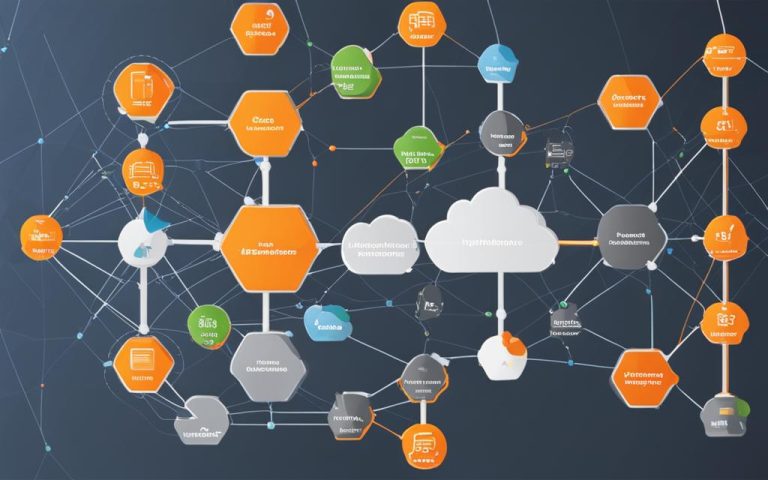Welcome to our comprehensive guide on cloud management. In today’s digital era, cloud computing has become an integral part of businesses, facilitating seamless operations across various industries. Cloud management is the key to harnessing the power of cloud computing and maximizing its benefits.
Whether you are using public, private, hybrid, or multicloud environments, it’s crucial to have a clear understanding of cloud management and how it can optimize your cloud resources, infrastructure, and services.
In this guide, we will explore the concept of cloud management, its challenges, benefits, and the tools and technologies available to streamline your cloud network management. We will also discuss the key considerations for developing a robust cloud management strategy that aligns with your business needs.
Stay with us as we navigate through the world of cloud management and equip you with the knowledge and insights to effectively manage your cloud computing environment.
What is Cloud Management?
Cloud management involves the organized management of cloud computing products and services in various cloud environments, such as public, private, hybrid, or multicloud. It encompasses processes, strategies, policies, and technology to control and maintain cloud resources, infrastructure, and services. Cloud management is essential for organizations operating in the cloud to evaluate, monitor, and manage cloud computing resources efficiently. It includes tasks like provisioning, orchestration, automation, lifecycle management, cost optimization, performance monitoring, and security. Cloud management tools help streamline cloud, API, and application management tasks, providing organizations with control, visibility, and scalability in their cloud environments.
Cloud management is the backbone of effective and efficient cloud computing. It ensures that organizations can harness the full potential of their cloud resources and achieve their business goals. By implementing cloud management practices and utilizing robust cloud management tools, organizations can optimize resource allocation, monitor performance, automate processes, and enhance security in their cloud environments.
Cloud management solutions enable businesses to effectively provision resources, allocate workloads, and manage applications in public, private, hybrid, or multicloud environments. These tools provide centralized control and monitoring capabilities, allowing organizations to have complete visibility over their cloud infrastructure. With the ability to automate processes and streamline operations, Cloud Network Management Tools enhance productivity and reduce manual efforts in managing cloud resources.
Furthermore, cloud management facilitates cost optimization by monitoring resource usage, identifying inefficiencies, and allowing organizations to right-size their cloud infrastructure. This ensures that organizations only spend on the resources they need, leading to significant cost savings.
Security is another crucial aspect of cloud management. Cloud management tools enable organizations to implement robust security measures, monitor for potential vulnerabilities, and enforce compliance policies across their cloud environments. By integrating security measures throughout the cloud management lifecycle, organizations can protect their data, applications, and infrastructure from threats.
Overall, cloud management is essential for organizations to effectively utilize the power of cloud computing. By implementing the right cloud management strategies and utilizing advanced cloud management tools, organizations can achieve optimal performance, scalability, security, and cost efficiency in their cloud environments.
Challenges and Benefits of Cloud Management
As organizations increasingly rely on cloud computing, they face challenges in managing complex architectures and gaining oversight of their cloud environments. Cloud environments can be spread across multiple cloud platforms or mixed with on-premises infrastructure, hybrid cloud, or multicloud. This can lead to cloud sprawl, where the number of cloud resources grows uncontrollably, causing increased costs, security risks, and management complexities. Estimating and optimizing cloud costs can also be challenging.
However, effective cloud management offers several benefits, including:
- Enhanced control and visibility over cloud resources and services
- Scalability to meet changing business needs and workload demands
- Compliance with industry regulations and data governance
- Enhanced security posture to mitigate potential risks
- Cost management and optimization to maximize return on investment
- Improved operational efficiency and streamlined processes
Cloud management tools provide features like automation, monitoring, application management, security, and cost optimization to address these challenges and leverage the benefits of cloud computing. By effectively managing their cloud environments, organizations can achieve better control, increased scalability, enhanced security, and optimized costs.
Benefits of Cloud Management
“Cloud management tools enable organizations to effectively manage their cloud environments, providing control, visibility, scalability, and security. By leveraging these tools, organizations can optimize costs, improve operational efficiency, and drive innovation in their cloud infrastructure.”
Cost Optimization in Cloud Management
| Cost Optimization Strategies | Benefits |
|---|---|
| 1. Right-sizing resources | • Reduces unnecessary spending on over-provisioned instances. • Improves cost efficiency and resource utilization. |
| 2. Implementing auto-scaling | • Ensures resources are scaled up or down as per workload demands. • Optimizes resource allocation and cost savings. |
| 3. Utilizing spot instances or reserved instances | • Takes advantage of discounted pricing options. • Maximizes cost savings for non-critical workloads or long-term commitments. |
| 4. Analyzing and optimizing storage usage | • Identifies unused or underutilized storage resources. • Reduces storage costs and improves efficiency. |
By adopting these cost optimization strategies and leveraging cloud management tools, organizations can minimize unnecessary expenses and achieve significant cost savings in their cloud environments.

Cloud Management Tools and Technologies
Cloud management tools and technologies are essential for organizations to effectively oversee and manage their cloud environments. These tools provide a wide range of features and functionalities that enable efficient cloud management across different cloud platforms and environments.
Key features of cloud management tools include:
- Application management: Cloud management tools allow organizations to monitor and manage their cloud applications, ensuring optimal performance and availability.
- Monitoring and observability: These tools provide real-time monitoring and visibility into cloud resources, helping organizations identify performance issues and make data-driven decisions.
- Configuration and provisioning: Cloud management tools streamline the process of configuring and provisioning cloud resources, enabling organizations to quickly deploy and scale their applications in the cloud.
- Compliance and auditing: These tools ensure that organizations adhere to industry-specific regulations and security standards, helping them maintain compliance in their cloud environments.
- Governance: Cloud management tools offer governance frameworks and policies that help organizations establish rules and processes for managing their cloud resources and controlling access.
- Centralized operations management: With cloud management tools, organizations can centralize their cloud operations, making it easier to manage and monitor their cloud environments.
- Cloud financial management: These tools provide cost management and optimization features, allowing organizations to track and manage their cloud expenses effectively.
Popular cloud management tools and technologies in the market today include:
| Cloud Management Tools | Features |
|---|---|
| Google Cloud management tools | Application management, monitoring, configuration, compliance, centralized operations management, cloud financial management |
| AWS CloudWatch | Monitoring, resource optimization, compliance, auditing |
| Microsoft Azure Monitor | Application monitoring, diagnostics, performance optimization |
| Google Cloud Operations | Monitoring, observability, proactive incident management |
| Datadog | Monitoring, troubleshooting, infrastructure optimization, security monitoring |
| AppDynamics | Application performance monitoring, diagnostics, business transaction tracing |
| New Relic | Application performance monitoring, real-time analytics, incident response |
| Prometheus | Monitoring, alerting, time series database |
| Dynatrace | Full-stack observability, AI-powered analytics, real-time insights |
| PagerDuty | Incident response orchestration, real-time operations, on-call management |
| Splunk | Machine data analytics, monitoring, security analysis |
These cloud management tools help organizations streamline their cloud management processes, improve operational efficiency, enhance security, optimize costs, and drive innovation in their cloud environments.
Implementing the right cloud management tools and technologies is crucial for organizations seeking to unlock the full potential of their cloud environments.
Key Considerations for Cloud Management Strategy
Developing a robust cloud management strategy is crucial for organizations to effectively manage their cloud environments. A well-defined strategy enables consistent control across environments, ensures compliance and security, allows for agile change management, provides centralized operations management, and offers effective cost management.
When developing a cloud management strategy, organizations should consider various key factors:
Provisioning and Orchestration
Provisioning and orchestration play a vital role in managing cloud resources. Effective provisioning ensures that the right resources are available when needed, and orchestration helps automate complex workflows and streamline processes.
Monitoring and Observability
Having robust monitoring and observability capabilities is essential for proactive management of cloud environments. Real-time monitoring and actionable insights enable organizations to identify and address issues promptly, ensure optimal performance, and deliver an exceptional user experience.
Configuration, Compliance, and Auditing
Establishing and maintaining configuration, compliance, and auditing practices are crucial for maintaining security and regulatory compliance. Organizations need to manage configurations, enforce policies, and conduct regular audits to mitigate risks and ensure adherence to industry standards and regulations.
Governance
Governance in cloud management involves establishing policies, processes, and controls to ensure consistency, accountability, and alignment with organizational objectives. It helps organizations maintain control and make informed decisions, facilitating effective utilization of cloud resources and services.
Cost Management
Cost management is one of the key considerations in cloud management. Organizations need to optimize cloud costs by monitoring resource usage, identifying cost-saving opportunities, and implementing strategies to eliminate wastage and unnecessary expenses.
By considering these key factors and aligning the cloud management strategy with their business needs, organizations can effectively manage their cloud environments, scale their cloud workloads, and maintain control, security, and efficiency.
Implementing a comprehensive cloud management strategy requires the right combination of processes, technologies, and skill sets. It enables organizations to harness the full potential of cloud computing, drive innovation, and achieve their digital transformation goals.
Conclusion
Cloud management is a critical practice that enables organizations to efficiently manage their cloud computing resources, infrastructure, and services. As the adoption of cloud computing continues to grow, organizations face challenges in managing complex cloud environments. However, by leveraging cloud management tools and technologies, these challenges can be overcome, and optimal cloud network management can be achieved.
Developing a strong cloud management strategy is crucial for organizations to address key considerations such as provisioning, monitoring, compliance, governance, and cost management. By adopting the right cloud management tools and implementing an effective strategy, organizations can gain control, visibility, and scalability in their cloud environments, ensuring efficient and secure digital transformation.
Cloud management not only provides organizations with the ability to control and maintain their cloud resources, but it also offers benefits such as improved IT performance, enhanced security, optimized costs, and the ability to drive innovation. By embracing cloud management as a strategic approach, organizations can harness the full potential of cloud computing and stay ahead in today’s digital landscape.
FAQ
What is cloud management?
Cloud management refers to the organized management of cloud computing products and services in various cloud environments, such as public, private, hybrid, or multicloud. It involves processes, strategies, policies, and technology to control and maintain cloud resources, infrastructure, and services.
Why is cloud management important?
Cloud management is essential to ensure smooth operations, improve IT performance, enhance security, optimize costs, and drive digital transformation. It allows organizations to efficiently evaluate, monitor, and manage their cloud computing resources, enabling them to scale their cloud workloads while maintaining control, security, and efficiency.
What are the benefits of effective cloud management?
Effective cloud management offers enhanced control, visibility, scalability, compliance, security, cost management, and improved operational efficiency. It helps organizations overcome challenges such as cloud sprawl, increased costs, security risks, and management complexities, allowing them to leverage the benefits of cloud computing.
Which cloud management tools are popular?
Some popular cloud management tools include Google Cloud management tools, AWS CloudWatch, Microsoft Azure Monitor, Google Cloud Operations, Datadog, AppDynamics, New Relic, Prometheus, Dynatrace, PagerDuty, and Splunk. These tools provide features like automation, monitoring, application management, security, and cost optimization to streamline cloud management processes.
What factors should organizations consider when developing a cloud management strategy?
When developing a cloud management strategy, organizations should consider factors like provisioning and orchestration, monitoring and observability, configuration, compliance, auditing, governance, and cost management. A strong cloud management strategy should enable consistent control across environments, allow for agile change management, ensure compliance and security, provide centralized operations management, and offer effective cost management.
How can organizations overcome challenges in managing complex cloud environments?
By adopting cloud management tools and technologies, organizations can overcome challenges in managing complex cloud environments. These tools offer a wide range of features and functionalities, such as application management, monitoring and observability, configuration, compliance, auditing, governance, centralized operations management, and cloud financial management. They integrate with different cloud platforms and environments, providing organizations with comprehensive cloud management solutions.



















